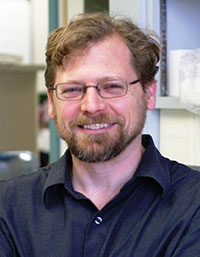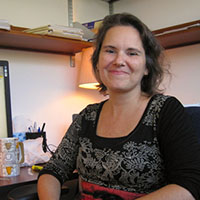Principaux conférenciers
|
Guillaume Bourque, |
Comparative epigenomic resources to better understand non-coding DNA
To refine our understanding of non-coding DNA, consortiums such as ENCODE, the NIH Roadmap and the International Human Epigenome Consortium (IHEC) have released more than 9000 epigenomic maps across multiple human cell types. This work has lead to the assignment of a biochemical function to nearly 80% of the human genome. We present an overview of some of the resources that have been made available by these consortiums, including the IHEC Data Portal (www.epigenomesportal.ca/ihec), which we have developed. Following this, we describe a few examples of integrative analyses that make use of these datasets. We start by showing that transposable elements (TEs) have been a major contributor to biochemical activity in the human genome by driving some of the regulatory and transcript innovation. In particular, using DNase I hypersensitivity data sets from ENCODE in normal, embryonic, and cancer cells, we show that 44% of open chromatin regions are in TEs and that this proportion reaches 63% for primate-specific regions. Beyond their impact on host gene regulation, we demonstrate that TEs have also been major contributors to the origin and diversification of long noncoding RNAs (lncRNAs). Going forward, we propose that inter-species epigenomic datasets will be key to better understand the evolution and the role of non-coding DNA. Using data from different human individuals and from non-human primate species, we show that these data can help prioritize non-coding variants for disease studies. |
|---|---|
|
Josée Dostie, Department of Biochemistry and Goodman Cancer, |
The reciprocity of genome architecture and gene expression
Human health is a state afforded by the proper functioning of cells. There are many ways in which cells may not adequately respond to their environment, and the molecular mechanisms leading to these defects are as diverse as they are many. In this seminar, I will report on how spatial chromatin organization contributes to the proper expression of genes. I will also touch on the emerging role of long noncoding RNAs (lncRNAs) in shaping chromatin organization and activity. Thousands of lncRNA genes have been identified in mammalian genomes, and although several represent important regulators of gene expression, the mechanisms by which they control transcription remain largely uncharacterized. The HOX gene clusters encode numerous lncRNA genes and have been used as paradigm in the study of various biological pathways. I will present the functional analysis of a HOX-encoded lncRNA gene named HOTAIRM1, which demonstrates that lncRNAs can have distinct functions in different cell types. Our study suggests that transcriptional regulation by a lncRNA can be guided by multiple factors including the type of variant expressed, the chromatin landscape surrounding both lncRNA and target genes, and by their physical proximity in three-dimensional space. |
Edward Marcotte, Institute for Cellular and Molecular Biology, University of Texas at Austin, USA  |
Comparative proteomics: Insights into protein function from deeply conserved gene modules
I’ll describe our attempts to test the extent to which deeply homologous genes and pathways are predictive across distant eukaryotic species, including our search for new models of human disease among phenotypes of distant organisms, our attempts to systematically humanize yeast cells, and our program to apply high-throughput protein mass spectrometry in order to measure conserved physical interactions among the thousands of proteins shared across the eukaryotic tree of life. Studies such as these reveal the evolutionary basis for traits and diseases, help annotate the expressed proteomes of major eukaryotic lineages, and reveal the evolutionary conservation, divergence, and rewiring of protein complexes across eukaryotic proteomes.
|
| Rebekah Rogers, Department of Integrative Biology, University of California, Berkeley, USA |
Chromosomal rearrangements as barriers to genetic homogenization between archaic and modern humans
Chromosomal rearrangements, which shuffle DNA across the genome, are an important source of divergence across taxa that can modify gene expression and function. Using a paired-end read approach with Illumina sequence data for archaic humans, I identify changes in genome structure that occurred recently in human evolution. Hundreds of rearrangements indicate genomic trafficking between the sex chromosomes and autosomes, raising the possibility of sex-specific changes. Additionally, genes adjacent to genome structure changes in Neanderthals are associated with testis-specific expression, consistent with evolutionary theory that new genes commonly form with expression in the testes. I identify one case of new-gene creation through transposition from the Y chromosome to chromosome 10 that combines the 5' end of the testis-specific gene Fank1 with previously untranscribed sequence. This new transcript experienced copy number expansion in archaic genomes, indicating rapid genomic change. Finally, loci containing genome structure changes show diminished rates of introgression from Neanderthals into modern humans, consistent with the hypothesis that rearrangements serve as barriers to gene flow during hybridization. Together, these results suggest that this previously unidentified source of genomic variation has important biological consequences in human evolution.
|
| Sohrab Shah, BC Cancer Agency, 
|
Evolutionary dynamics of cancer: a spatio-temporal analysis
I will discuss the importance of evolutionary dynamics in the study of cancer initiation and progression. I will present results from two genomics studies of major human malignancies: follicular lymphoma and serous ovarian cancer through the lens of evolutionary theory. This includes reconstructing population structure through measurement of alleles and computational analysis and using phylogenetics to determine clone- or clade-level properties of cancers at diagnosis and at progression states. I will conclude by emphasizing novel biological insights that can be gained through precise application of genome sequencing and requisite computational analysis to primary human cancer tissue. |



